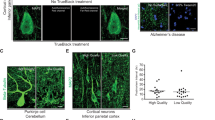Abstract
The Alzheimer’s disease (AD) β-amyloid precursor protein (APP) and the amyloid precursor-like protein 1 (APLP1) and 2 (APLP2) are members of a superfamily of proteins that appear functionally related. Although APLPs are highly homologous to APP in the N- and C-terminal domains, they lack the βA4/amyloid peptide, i.e., the main constituent of neuritic plaques in AD. To assess a potential role of APLP1 in AD, we have determined its immunohistochemical distribution in human hippocampal formation, a structure which is strongly affected in AD, and compared it with APP immunoreactivity. There was a considerable overlap of APP and APLP1 regional expression patterns. Significant APLP1 immunoreactivity was observed in neuritic plaques. Large pyramidal neurons of the subiculum showed an accumulation of APLP1 protein in their dendritic compartment. Some astrocytes elicited perinuclear APLP1 staining, but this was observed in both AD and control brains. These findings raise the possibility that APLP1 may contribute to the pathogenesis of AD-associated neurodegeneration.
Similar content being viewed by others
Author information
Authors and Affiliations
Additional information
Received: 28 July 1997 / Revised: 28 August 1997 / Accepted: 8 September 1997
Rights and permissions
About this article
Cite this article
Bayer, T., Paliga, K., Weggen, S. et al. Amyloid precursor-like protein 1 accumulates in neuritic plaques in Alzheimer’s disease. Acta Neuropathol 94, 519–524 (1997). https://doi.org/10.1007/s004010050745
Issue Date:
DOI: https://doi.org/10.1007/s004010050745




